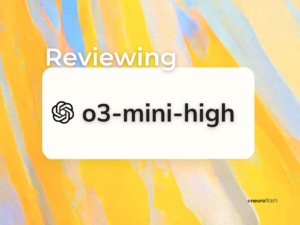What is AI in Image Recognition?
AI in Image Recognition is a technology that uses artificial intelligence and machine learning algorithms to analyze digital images and identify the objects contained in them. This process involves the recognition of patterns, shapes, colors, and textures that help machines interpret complex visual data. Through AI in Image Recognition, it is possible to teach machines to identify and classify objects in a way that is similar to how the human brain works.
NeuroFlash offers a Free trial version of its AI-powered image recognition software, which can help you automate image recognition processes in a quick and easy way. Check it out here.
How does AI in Image Recognition work?
AI in Image Recognition works through a process of training and recognition. First, a large dataset of images is used to train an AI model to recognize objects of interest. This process relies on the use of machine learning algorithms like Convolutional Neural Networks (CNNs) that help machines identify specific patterns in images. Once the model is trained, it can be used to recognize objects in new images, which it does by comparing these images to the ones it has learned from before.
NeuroFlash’s AI Book Writer and AI Font Generator are two examples of how AI technology can be used to automate tasks. Check them out here and here, respectively.
Applications of AI in Image Recognition
AI in Image Recognition has numerous applications across different industries such as healthcare, security, education, retail, and marketing. Some examples include:
- Medical image analysis: AI in Image Recognition can help doctors diagnose diseases and injuries by analyzing X-rays, MRI scans, and CT scans with high precision.
- Security and surveillance: AI in Image Recognition can monitor footage from security cameras and identify potential threats or suspicious behavior.
- Retail: AI in Image Recognition can help retailers track their inventory, monitor customer behavior, and personalize the shopping experience
Advantages of AI in Image Recognition
AI in Image Recognition has several advantages that make it a valuable tool for businesses:
- Accuracy and Efficiency: AI in Image Recognition can analyze images with high precision and speed, reducing the risk of human error and increasing productivity.
- Cost-effectiveness: AI in Image Recognition can help businesses save costs by automating repetitive and time-consuming tasks.
- Scalability: AI in Image Recognition can be scaled up or down depending on the volume of images that need to be analyzed.
NeuroFlash’s blog on digital marketing agency describes how businesses can benefit from AI-based solutions.
Challenges and Limitations of AI in Image Recognition
Despite the advantages of AI in Image Recognition, there are some challenges and limitations that need to be considered:
- Training data: AI in Image Recognition relies heavily on high-quality and diverse training data to achieve accurate results.
- Specificity: AI in Image Recognition may struggle to recognize objects that are not part of its training dataset or that have ambiguous characteristics.
- Ethical concerns: AI in Image Recognition can raise ethical concerns related to privacy, security, and bias in decision-making processes.
Related Questions
What are the different techniques used in AI Image Recognition?
There are various techniques used in AI Image Recognition, such as Convolutional Neural Networks (CNNs), Support Vector Machines (SVMs), and Random Forest Models. Each technique has its strengths, and choosing the right one involves a careful consideration of the data and the objectives of the analysis.
How accurate is AI in Image Recognition?
The accuracy of AI in Image Recognition depends on several factors, including the quality and diversity of the training dataset, the specific techniques used, and the complexity of the objects being analyzed. In general, with high-quality data and state-of-the-art algorithms, AI in Image Recognition can achieve very high levels of accuracy.
What industries benefit the most from AI in Image Recognition?
AI in Image Recognition has applications in several industries, but those that benefit most are typically those that rely heavily on visual data, such as healthcare, security, retail, and marketing. These industries can use AI in Image Recognition to automate tasks, improve accuracy, and reduce costs.
Other People Asked
What is image recognition in artificial intelligence?
Image recognition in artificial intelligence is the process of teaching machines to analyze digital images and identify the objects contained in them. This process involves the use of various technologies such as computer vision, machine learning, and deep learning algorithms that help machines interpret visual data and classify it based on specific attributes.
What are the common techniques used in AI image recognition?
The common techniques used in AI Image Recognition include Convolutional Neural Networks (CNNs), Support Vector Machines (SVMs), Random Forest Models, and Deep Learning algorithms. These techniques utilize complex mathematical functions to interpret and analyze digital images and extract relevant features from them.
How does convolutional neural network (CNN) help in image recognition?
Convolutional Neural Networks (CNNs) are a type of neural network that are particularly well-suited to image recognition tasks. They are designed to recognize complex spatial patterns in images by operating on smaller local regions of the image at a time. This makes them highly effective at recognizing features such as edges and textures that are essential in identifying objects in images.
What are the real-world applications of AI image recognition?
AI Image Recognition has numerous real-world applications, including medical image analysis, security and surveillance, retail, marketing, and education. These applications can involve tasks such as disease diagnosis, threat detection, inventory tracking, and content personalization.
How can AI image recognition be used to improve content management systems?
AI Image Recognition can be used to improve content management systems by automating tasks such as tagging and categorizing content, optimizing image resolution, and identifying duplicates. This can save time, improve search functionality, and enhance user experience. Furthermore, AI-based solutions like NeuroFlash’s Image Recognition Software can help businesses optimize their image recognition processes and stay ahead of the competition.










